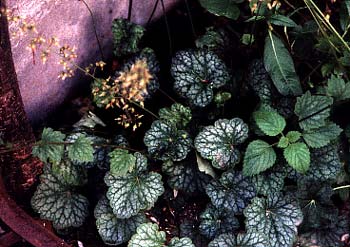 'Dale's Strain'
'Dale's Strain'
Rock Geranium
"With a few flowers in my garden,
half a dozen pictures, & some books,
I live without envy."
-Lope de Vega,
1562-1635
1562-1635
I dropped in at a small nursery late in winter even though such places don't restock until spring & might as well just close up & go on vacation. Stocks were thin, not much of interest, but I felt compelled to find something for at least a token purchase so that I wouldn't be yet another almost-customer to leave totally empty-handed in the off-season.
I saw some crinkly bright orange leaves in small pots. Heuchera fans are legion but I was slow to grasp their enthusiasm. Nothing wrong with 'em, but when someone has collected fifteen different cultivars & looking for others all very similar, I still entirely understand that. But my own interest in things of winter interest made me look at this Heuchera much more closely. It was 'Dale's Strain' of Heuchera americana, also called Rock-Geranium, Alum Root, or American Sanicle. Heucheras are commonly called Coral Bells, but that would be a misnomer on this one, as it does not have the brightly colored little bell-flowers dangling on stalks. It has inconspicuous greenish-white blossoms, so this rock geranium's appeal is more wholly in the leaves. The blooms first appear at the end of spring or very beginning of summer. When they are spent, if the panicles are clipped off, it will bloom one more time before autumn even as the leaves are beginning to turn to bright golden orange.
So it is liked mainly for the unusual evergreen foliage. Rather than dry out or die back, the leaves turn the brightest orange for autumn then persist through the whole of winter. Early spring is the time to cut most of that stuff off to make room for new silvery-green leaves. The mottled leaves are gorgeous in spring & summer, as is shown in the July photograph above. The photo also shows the unassuming panicles of flowers, not to mention an unwanted bit of lemon balm that needs weeding out of the heuchera.
Heucheras have tough knotty roots used in traditional medicines by Native Americans. It has powerfully astringent properties, hence the name Alum Root or Alumroot.
This variety can grow to two feet in height though is usually shorter, forming a rounded clump. It is adaptable as to condition but seems to like best humousy moist soil in a half sun, half shade. But it can adapt to drier poorer soils, & does fine with almost any lighting situation. We've given it rich soil & some afternoon-sun, protected somewhat in the shadow of Viburnum trilobum.